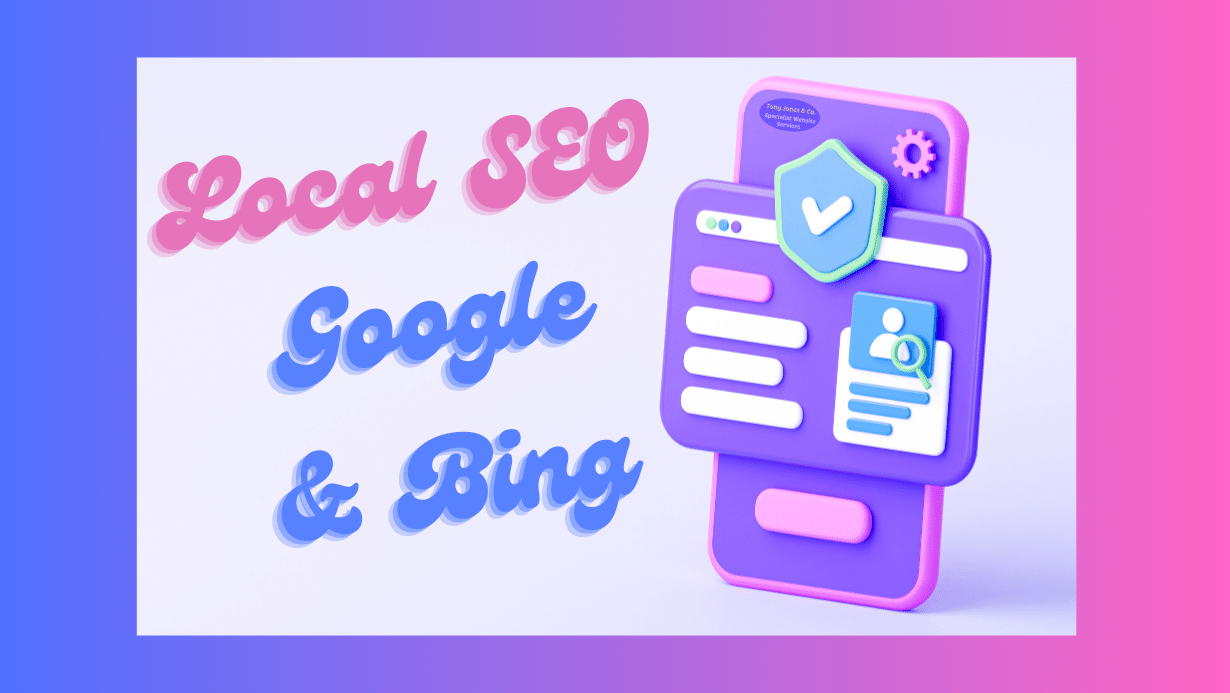Web Designer Wrexham, Professional Website Services - Tony Jones CITP, FBCS.
Empowering Your Online Journey: Website Essentials for Small Businesses
The Importance of a Business Website

In today's digital age, having a business website is essential for small businesses. It serves as a powerful tool that enables businesses to establish an online presence, reach a wider audience, and build credibility.
Establishing an Online Presence
Having a website allows your small business to establish a strong online presence. It serves as a virtual storefront where potential customers can learn about your products or services. With the majority of consumers turning to the internet to find information, not having a website can mean missing out on valuable opportunities.
A well-designed and informative website showcases your brand, highlights your offerings, and provides key information about your business. It allows you to present your business story, values, and unique selling points to potential customers. By having an online presence, you increase your visibility and make it easier for people to discover and connect with your business.
Reaching a Wider Audience
A business website provides the opportunity to reach a wider audience beyond your local area. With a website, your business can be accessible to anyone with an internet connection, expanding your potential customer base. It allows you to tap into new markets, target specific demographics, and potentially attract customers from different geographic locations.
Through effective search engine optimization (SEO) techniques, you can improve your website's visibility in search engine results and attract organic traffic. Implementing relevant keywords, providing valuable content, and optimizing your metadata are just a few ways to enhance your website's SEO. For more information on SEO for small business websites, check out our article on SEO for small business websites.
Building Credibility
A well-designed and professional website helps build credibility for your small business. It conveys a sense of professionalism and reliability, instilling confidence in potential customers. A website with a clean and user-friendly interface, engaging content, and clear contact information creates a positive impression and signals that your business is trustworthy.
Including testimonials and reviews from satisfied customers on your website further enhances your credibility. Positive feedback from others can influence potential customers' decision-making process. Additionally, displaying trust seals and badges, such as security certifications or industry affiliations, can provide reassurance to visitors. For more information on building trust and credibility, check out our article on small business website security measures.
By establishing an online presence, reaching a wider audience, and building credibility, a business website becomes an invaluable asset for small businesses. It acts as a platform to showcase your brand, connect with customers, and drive growth. Make sure to regularly monitor your website's performance using website analytics to gain insights into visitor behavior and optimize your online presence. For more information on website analytics for small businesses, visit our article on website analytics for small businesses.
Planning Your Small Business Website
Before diving into the creation of your small business website, it's crucial to have a solid plan in place. This section will guide you through three essential steps: defining your goals and objectives, identifying your target audience, and choosing the right domain name.
Defining Your Goals and Objectives
To create an effective website, it's essential to have a clear understanding of your goals and objectives. Ask yourself what you want to achieve with your website. Are you looking to increase online sales, generate leads, or simply provide information about your products or services?
By defining your goals and objectives, you can align your website content, design, and functionality to meet your specific needs. This clarity will guide you in making informed decisions throughout the website creation process. For more information on setting up a small business website, check out our article on small business website requirements.
Identifying Your Target Audience
Understanding your target audience is crucial for developing a website that resonates with your potential customers. Identify the demographic characteristics of your target audience, such as age, gender, location, and interests. This information will help you tailor your website content and design to cater to their needs and preferences.
Consider conducting market research, surveys, or analyzing your competitors to gain insights into your target audience. By understanding their pain points, interests, and expectations, you can create a website that effectively engages and converts visitors into customers.
Choosing the Right Domain Name
Selecting the right domain name is a crucial aspect of your small business website. Your domain name should reflect your brand, be concise, and easy to remember. Ideally, it should include relevant keywords that are associated with your business.
When choosing a domain name, consider the following tips:
- Keep it short and simple: A shorter domain name is easier to remember and type.
- Include relevant keywords: Incorporating relevant keywords in your domain name can help with search engine optimization (SEO) efforts. For more information on SEO for small business websites, visit our article on seo for small business websites.
- Make it brandable: A domain name that aligns with your brand identity helps in building brand recognition and trust.
- Choose the right domain extension: Consider using domain extensions like .com, .co.uk, or .net, depending on your target audience and business location.
By carefully selecting a domain name that represents your brand and appeals to your target audience, you set a strong foundation for your small business website.
By defining your goals and objectives, identifying your target audience, and choosing the right domain name, you are laying the groundwork for a successful small business website. These initial steps will ensure that your website is purposeful, engaging, and aligned with your business objectives.
Essential Website Components
When setting up a small business website, it's essential to include certain components to ensure a positive user experience and effectively convey your business information. Let's explore the key elements that every small business website should have: user-friendly navigation, an engaging homepage, an About Us page, a Products/Services page, and comprehensive contact information.
User-Friendly Navigation
A user-friendly navigation system is crucial for guiding visitors through your website. It should be intuitive and easy to understand, allowing users to move seamlessly between pages. Consider organizing your navigation menu logically, grouping related pages together. This helps visitors quickly find the information they need and enhances their overall browsing experience.
Engaging Homepage
Your homepage acts as the virtual front door to your small business website. It should be visually appealing, engaging, and provide a clear overview of your business. Highlight key features of your products or services, and use compelling visuals to capture visitors' attention. Additionally, consider incorporating a call-to-action that directs users to take the next step, such as signing up for a newsletter or exploring your product offerings.
About Us Page
The About Us page provides an opportunity to share your small business's story and build a connection with your audience. Use this space to explain your company's mission, values, and history. Include information about your team, their expertise, and what sets your business apart from others. This page allows visitors to get to know your brand on a deeper level and fosters trust and credibility.
Products/Services Page
The Products/Services page is where you showcase what you offer. Provide detailed descriptions of your products or services, including their features, benefits, and pricing if applicable. Consider organizing your offerings into categories or sections to make it easy for visitors to browse and find what they are looking for. Including high-quality images or videos can also enhance the user experience and help potential customers visualize your offerings.
Contact Information
Including comprehensive contact information on your small business website is essential for potential customers to get in touch with you. Make sure to include your business phone number, email address, and a contact form for visitors to reach out to you directly. Additionally, consider providing your business address and links to your social media profiles to further connect with your audience. This information builds trust and allows visitors to easily engage with your business.
By incorporating these essential components into your small business website, you can provide a seamless browsing experience for your visitors while effectively conveying your business information. Remember to regularly update and maintain these components to ensure they stay relevant and accurate. To learn more about optimizing your small business website for search engines, check out our article on SEO for small business websites.
Design and Branding
When it comes to creating a successful small business website, design and branding play a crucial role in attracting and engaging visitors. A well-designed website that aligns with your brand identity can leave a lasting impression on your audience. In this section, we will explore three essential aspects of design and branding: consistent branding elements, professional and clean design, and mobile responsiveness.
Consistent Branding Elements
Consistency in branding is key to establishing a strong and memorable identity for your small business. Your website should reflect your brand's personality and values through consistent branding elements. These include your logo, color palette, typography, and overall visual style.
By integrating your logo prominently throughout the website, you create a visual connection between your brand and your audience. Consistent use of colors and fonts enhances brand recognition and creates a cohesive look and feel. This consistency helps to build familiarity and trust with your visitors.
Professional and Clean Design
A professional and clean design is essential for creating a positive user experience and conveying a sense of trustworthiness. Your website should have a clear and intuitive navigation structure, making it easy for visitors to find the information they need. Utilize clear headings, subheadings, and a logical hierarchy to guide users through your website.
Incorporate whitespace strategically to enhance readability and give your website a clean and uncluttered appearance. Avoid overcrowding the pages with excessive text or images. Instead, focus on presenting your content in a concise and visually appealing manner.
It's important to keep in mind that design trends evolve over time. Stay updated with the latest small business website design tips to ensure your website remains modern and engaging. For more information on small business website design, check out our article on small business website design tips.
Mobile Responsiveness
In today's digital landscape, mobile responsiveness is no longer an option but a necessity. With a significant portion of internet users accessing websites through mobile devices, it's vital to ensure that your website is optimized for mobile viewing.
A mobile-responsive design allows your website to adapt and provide an optimal browsing experience across different screen sizes and devices. It ensures that your content is easily readable and navigable, regardless of whether it's accessed from a desktop, laptop, tablet, or smartphone.
Mobile responsiveness not only enhances user experience but also plays a crucial role in search engine optimization (SEO). Search engines prioritize mobile-friendly websites in their rankings, making it essential for your small business website to be mobile-responsive. To learn more about SEO for small business websites, check out our article on SEO for small business websites.
By focusing on consistent branding elements, professional and clean design, and mobile responsiveness, you can create a visually appealing and user-friendly website that effectively represents your small business. Remember, your website is often the first point of contact for potential customers, so make sure it leaves a positive and lasting impression.
Optimizing for Search Engines
To ensure your small business website gets the visibility it deserves, optimizing it for search engines is crucial. This involves implementing strategies to improve your website's ranking in search engine results pages (SERPs). Three key aspects of search engine optimization (SEO) are keyword research, on-page SEO, and metadata optimization.
Keyword Research
Keyword research is the foundation of any successful SEO strategy. It involves identifying the keywords and key phrases that your target audience uses when searching for products or services related to your business. By understanding these keywords, you can optimize your website's content to match the search intent of your potential customers.
Start by brainstorming a list of relevant keywords and phrases that are directly related to your small business. Then, use keyword research tools or online resources to identify popular and frequently searched terms. Consider both short-tail and long-tail keywords. Short-tail keywords are broad terms, while long-tail keywords are more specific and usually have lower search volumes but higher conversion rates.
Once you have a list of keywords, strategically incorporate them into your website's content, including headings, titles, and body text. However, avoid keyword stuffing, as it can harm your SEO efforts. Instead, focus on creating high-quality, informative, and engaging content that naturally incorporates relevant keywords. For more guidance on SEO for small business websites, check out our article on SEO for small business websites.
On-Page SEO
On-page SEO refers to optimizing the elements within your website to improve its visibility in search results. It involves optimizing factors such as URL structure, heading tags, image alt tags, and internal linking.
To optimize your website's on-page SEO, ensure that your URLs are descriptive and include relevant keywords. Use heading tags (H1, H2, etc.) to structure your content and make it more readable for both users and search engines. Additionally, include descriptive alt tags for your images, allowing search engines to understand what the images represent.
Internal linking is another important aspect of on-page SEO. By linking relevant pages within your website, you help search engines understand the structure and hierarchy of your content. Internal links also encourage users to explore your website further, improving user experience. For more tips on small business website design, check out our article on small business website design tips.
Metadata Optimization
Metadata plays a crucial role in SEO, as it provides search engines with information about your web pages. The two key metadata elements you should focus on are title tags and meta descriptions.
The title tag is the main headline that appears in search engine results. It should accurately describe the content of the page and include relevant keywords. Keep it concise and compelling to entice users to click through to your website.
The meta description is a brief summary of the page's content that appears below the title tag in search results. It should provide a clear and concise overview of what users can expect when they visit your website. Incorporate relevant keywords naturally within the meta description to improve its visibility in search results.
By optimizing your website's metadata, you can improve its visibility and click-through rates in search results. For more information on small business website requirements, including security measures and website analytics, check out our articles on small business website requirements and website analytics for small businesses.
Remember, search engine optimization is an ongoing process. Regularly monitor your website's performance, make necessary adjustments, and stay up to date with the latest SEO best practices to ensure your small business website remains optimized and visible to your target audience.
Building Trust and Credibility
When it comes to your small business website, building trust and credibility is essential for attracting and retaining customers. By incorporating certain elements into your website, you can instill confidence in potential customers and establish a positive reputation. Here are three key components to consider: testimonials and reviews, trust seals and badges, and secure payment options.
Testimonials and Reviews
Testimonials and reviews provide social proof and can greatly influence a potential customer's decision to engage with your business. Displaying positive feedback from satisfied customers on your website helps build trust and credibility. Consider including a dedicated page or section where customers can leave reviews or testimonials. These testimonials can highlight the positive experiences customers have had with your products or services. Additionally, you can feature select testimonials on your homepage to immediately showcase the positive feedback to visitors. Encourage customers to leave reviews by providing links to popular review platforms, such as Google Reviews or Yelp. This will not only enhance your website's credibility but also positively impact your local search engine visibility.
Trust Seals and Badges
Trust seals and badges are visual indicators that reassure visitors that your website is safe and trustworthy. These badges are typically provided by reputable third-party organizations that verify the security measures and legitimacy of your business. For example, displaying a SSL (Secure Sockets Layer) certificate badge helps to secure the transmission of sensitive customer data and indicates that your website is secure. Other trust seals, such as those from payment gateways or industry associations, can further enhance your website's credibility. When visitors see these trust seals and badges, they are more likely to feel comfortable sharing their personal information or making a purchase.
Secure Payment Options
Offering secure payment options is crucial for building trust with potential customers. Ensure that your website provides a variety of secure payment methods, such as credit card payments, PayPal, or other trusted online payment systems. Displaying logos of accepted payment options on your website's checkout page can further enhance trust and credibility. Additionally, clearly communicate the security measures you have in place, such as SSL encryption, to protect customer information during the payment process. This reassures customers that their financial data is safe and encourages them to complete their transactions with confidence.
By incorporating testimonials and reviews, trust seals and badges, and secure payment options into your small business website, you can build trust and credibility with potential customers. Remember to regularly update your testimonials and reviews to showcase new feedback and maintain relevance. To learn more about website essentials for small businesses, check out our article on small business website requirements. Additionally, implementing SEO strategies and analyzing website analytics can further optimize your website's performance and enhance its credibility.
Website Maintenance and Updates
Once your small business website is up and running, it's important to prioritize regular maintenance and updates to ensure its optimal performance. This section will explore three crucial aspects of website maintenance: regular content updates, monitoring analytics, and security measures.
Regular Content Updates
Keeping your website content fresh and up to date is essential for engaging your audience and maintaining their interest. Regularly updating your content not only provides your visitors with new and relevant information but also helps improve your search engine rankings. Search engines value websites that consistently provide valuable and updated content, which can positively impact your organic traffic.
To ensure a smooth user experience, review your website regularly and make necessary updates to your products or services, blog posts, and any other relevant information. Regularly adding new content, such as blog articles or featured products, can also encourage repeat visits and keep your audience engaged. By incorporating relevant keywords and phrases, you can also improve your website's visibility in search engine results. If you need guidance on keyword research and search engine optimization (SEO), our article on SEO for small business websites can provide valuable insights.
Monitoring Analytics
Monitoring website analytics is crucial for understanding how your small business website is performing and identifying areas for improvement. Analytics provide valuable data about your website visitors, their behavior, and the effectiveness of your marketing efforts.
By regularly reviewing analytics data, you can gain insights into metrics such as website traffic, page views, bounce rates, and conversion rates. This information helps you understand which pages are performing well and which may need optimization. Make use of tools like Google Analytics to track and analyze your website data. Our article on website analytics for small businesses provides more in-depth information on leveraging analytics to improve your website's performance.
Security Measures
Protecting your small business website from security threats is of utmost importance. Implementing robust security measures helps safeguard your website and the sensitive information of your customers. Here are some essential security measures to consider:
- Regular Backups: Regularly backup your website data to protect against data loss in case of cyber attacks or technical issues.
- Secure Hosting: Choose a reputable hosting provider that offers secure server environments and implements necessary security protocols.
- SSL Certificate: Install an SSL certificate to encrypt data transmitted between your website and visitors, ensuring secure communication.
- Strong Passwords: Use strong passwords for all website accounts, including the content management system (CMS), FTP, and hosting accounts.
- Software Updates: Keep your website's CMS, plugins, and themes up to date to address any security vulnerabilities that may arise.
- Firewall and Malware Scanning: Implement a firewall to filter out malicious traffic and regularly scan your website for malware.
By implementing these security measures, you can protect your small business website and build trust with your customers. For more information on website security, refer to our article on small business website security measures.
Regular maintenance and updates are vital to ensure your small business website remains functional, secure, and relevant. By regularly updating your content, monitoring analytics, and implementing robust security measures, you can enhance the overall performance and success of your website.
Share on:
Questions or further information; please call Tony 07990 797302
About the author Tony Jones CITP FBCS:
An experienced and qualified Web Designer based in Wrexham, a Chartered IT Professional and a Fellow of the British Computer Society.
Contact us
More news and articles: - Websites, Design, SEO, Artificial Intelligence, anything Digital Technology.











